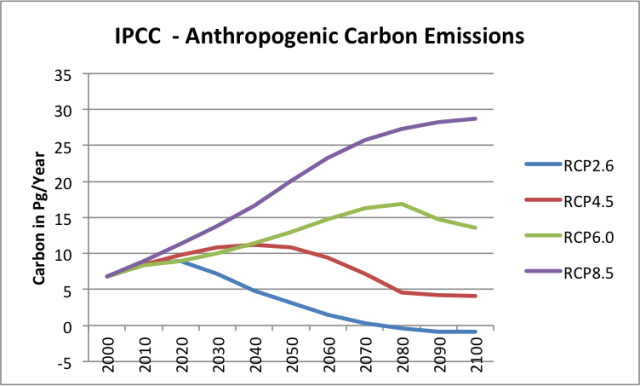We hear a lot about climate change, especially now that the Intergovernmental Panel on Climate Change (IPCC) has recently published another report. At the same time, oil is reaching limits, and this has an effect as well. How do the two issues fit together?
In simplest terms, what the situation means to me is that the “low scenario,” which the IPCC calls “RCP2.6,” is closest to what we can expect in terms of man-made carbon emissions. Thus, the most reasonable scenario, based on their modeling, would seem to be the purple bar that continues to rise for the next twenty years or so and then is close to horizontal.

Figure 1. Summary global average surface temperature change exhibit from new IPCC Report.
I come to this conclusion by looking at the tables of anthropogenic carbon emission shown in Annex II of the report. According to IPCC data, the four modeled scenarios have emissions indicated in Figure 2.

Figure 2. Total anthropogenic carbon emissions modeled for in the scenarios selected by the IPCC, based on data from Table All 2.a in Annex II.
The Likely Effect of Oil Limits
The likely effect of oil limits–one way or the other–is to bring down the economy, and because of this bring an end to pretty much all carbon emissions (not just oil) very quickly. There are several ways this could happen:
- High oil prices – we saw what these could do in 2008. They nearly sank the financial system. If they return, central banks have already done most of what they can to “fix” the situation. They are likely to be short of ammunition the next time around.
- Low oil prices – this is the current problem. Oil companies are cutting back on new expenditures because they cannot make money on a cash flow basis on shale plays and on other new oil drilling. Oil companies can’t just keep adding debt, so they are doing less investment. I talked about this in Beginning of the End? Oil Companies Cut Back on Spending. Less oil means either a rebound in prices or not enough oil produced to go around. Either way, we are likely to see massive recession and falling world GDP.
- Huge credit problems, such as happened in 2008, only worse. Oil drilling would stop within a few years, because oil prices would drop too low, and stay too low, without lots of credit to prop up prices of commodities of all types.
- Rapidly rising interest rates, as QE reaches its limits. (QE for the United States was put in place at the time of the 2008 crisis, and has been continued since then.) Rising interest rates lead to higher needed tax rates and high monthly payments for homes and cars. The current QE-induced bubble in stock, land, and home prices is also likely to break, sending prices down again.
- End of globalization, as countries form new alliances, such as Russia-China-Iran. The US is making false claims that we can get along without some parts of the world, because we have so much natural gas and oil. This is nonsense. Once groups of countries start pulling in opposite directions, the countries that have been using a disproportionate share of oil (particularly Europe, the United States, and Japan) will find themselves in deep trouble.
- Electric grid failures, because subsidies for renewables leave companies that sell fossil-fuel powered electricity with too little profit. The current payment system for renewables needs to be fixed to be fair to companies that generate electricity using fossil fuels. We cannot operate our economy on renewables alone, in part, because the quantity is far too small. Creation of new renewables and maintenance of such renewables is also fossil fuel dependent.
If any of these scenarios takes place and snowballs to a collapse of today’s economy, I expect that a rapid decline in fossil fuel consumption of all kinds will take place. This decline is likely to be more rapid than modeled in the RCP2.6 Scenario. The RCP2.6 Scenario assumes that anthropogenic carbon emissions will still be at 84% of 2010 levels in 2030. In comparison, my expectation (Figure 3, below) is that fossil fuel use (and thus anthropogenic carbon emissions) will be at a little less than 40% of 2010 levels in 2030.

Figure 3. Estimate of future energy production by author. Historical data based on BP adjusted to IEA groupings.
After 2070, the RCP2.6 Scenario indicates negative carbon emissions, presumably from geo-engineering. In my view of the future, such an approach seems unlikely if oil limits are a major problem, because without fossil fuels, we will not have the ability to use engineering approaches. It is also doubtful that there would be as much need for these engineered carbon-take-downs at the end of the period. Population would likely be much lower by then, so current anthropogenic carbon emissions would be less of a problem.
The Climate Change Scenario Not Modeled
We really don’t know what future climate change will look like because no one has tried to model what a collapse situation would look like. Presumably there will be a lot of tree-cutting and burning of biomass for fuel. This will change land use besides adding emissions from the burned biomass to the atmosphere. At the same time, emissions associated with fossil fuels will likely drop very rapidly.
Clearly the climate has been changing and will continue to change. At least part of our problem is that we have assumed that it is possible to have an unchanging world and have made huge investments assuming that climate would go along with our plans. Unfortunately, the way nature “works” is by repeatedly replacing one system with another system. The new systems that survive tend to be better adapted to recent changes in conditions. If we think of humans, other animals, and plants as “systems,” this is true of them as well. No living being can expect to survive forever.
Unfortunately economies are not permanent either. Just as the Roman Empire failed, our economy cannot last forever. In physics, economies seem to be examples of dissipative structures, just as plants and animals and hurricanes are. Dissipative structures are formed in the presence of flows of energy and matter in open thermodynamic systems–that is, systems that are constantly receiving a new flow of energy, as we on earth do from the sun. Unfortunately, dissipative structures don’t last forever.
Dissipative structures temporarily dissipate energy that is available. At the same time, they affect their surroundings. In the case of an economy, the use of energy permits the extraction of the most accessible, easy-to-extract resources, such as fossil fuels, metals, and fresh water. At the same time, population tends to grow. The combination of growing extraction and rising population leads to economic stresses.
At some point the economy becomes overly stressed because of limits of various types. Some of these limits are pollution-related, such as climate change. Other limits present themselves as higher costs, such as the need for deeper wells or desalination to provide water for a growing population, and the need for greater food productivity per acre because of more mouths to feed. The extraction of oil and other fossil fuels also provides a cost limit, as resource extraction becomes more complex, requiring a larger share of the output of the economy. When limits hit, governments are especially likely to suffer from inadequate funding and excessive debt, because tax revenue suffers if wages and profits drop.
People who haven’t thought much about the situation often believe that we can simply get along without our current economy. If we think about the situation, we would lose a great deal if we lost the connections that our current economy, and the financial system underlying it, offers. We as humans cannot “do it alone”–pull out metals and refine them with our bare hands, dig deeper wells, or keep up fossil fuel extraction. Re-establishing needed connections in a totally new economy would be a massive undertaking. Such connections are normally built up over decades or longer, as new businesses are formed, governments make laws, and consumers adapt to changing situations. Without oil, we cannot easily go back to horse and buggy!
Unfortunately, much of the writing related to dissipative structures and the economy is in French. François Roddier wrote a book called Thermodynamique de l’évolution on topics related to this subject. Matthieu Auzanneau writes about the issue on his blog. Roddier has a presentation available in French. One paper on a related topic in English is Energy Rate Density as a Complexity Metric and Evolutionary Driver by E. Chaisson. Causal Entropic Forces by Wissner-Gross and Freer provides evidence regarding how societies self-organize in ways that maximize entropy.
The IPCC’s Message Isn’t Really Right
We are bumping up against limits in many ways not modeled in the IPCC report. The RCP2.6 Scenario comes closest of the scenarios shown in providing an indication of our future situation. Clearly the climate is changing and will continue to change in ways that our planners never considered when they built cities and took out long-term loans. This is a problem not easily solved.
One of the big issues is that energy supplies seem to be leaving us, indirectly through economic changes that we have little control over. The IPCC report is written from the opposite viewpoint: we humans are in charge and need to decide to leave energy supplies. The view is that the economy, despite our energy problems, will return to robust growth. With this robust growth, our big problem will be climate change because of the huge amount of carbon emissions coming from fossil fuel burning.
Unfortunately, the real situation is that the laws of physics, rather than humans, are in charge. Basically, as economies grow, it takes increasing complexity to fix problems, as Joseph Tainter explained in his book, The Collapse of Complex Societies. Dissipative structures provide this ever-increasing complexity through higher “energy rate density” (explained in the Chaisson article linked above).
Now we are reaching limits in many ways, but we can’t–or dare not–model how all of these limits are hitting. We can, in theory, add more complexity to fix our problems–electric cars, renewable energy, higher city density, better education of women. These things would require more energy rate density. Ultimately, they seem to depend on the availability of more inexpensive energy–something that is increasingly unavailable.
The real issue is the danger that our economy will collapse in the near term. From the earth’s point of view, this is not a problem–it will create new dissipative structures in the future, and the best-adapted of these will survive. Climate will adapt to changing conditions, and different species will be favored as the climate changes. But from the point of view of those of us living on the planet earth, there is a distinct advantage to keeping business as usual going for as long as possible. A collapsed economy cannot support 7.2 billion people.
We need to understand what are really up against, if we are to think rationally about the future. It would be helpful if more people tried to understand the physics of the situation, even if it is a difficult subject. While we can’t really expect to “fix” the situation, we can perhaps better understand what “solutions” are likely to make the situation worse. Such knowledge will also provide a better context for understanding how climate change fits in with other limits we are reaching. Climate change is certainly not the whole problem, but it may still play a significant role.
